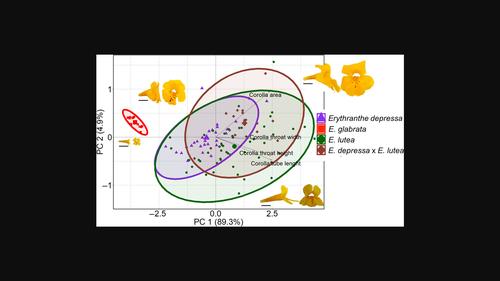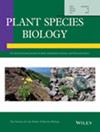Flower size constrains reproductive potential in three Andean monkeyflower species
IF 1.3
4区 生物学
Q4 ECOLOGY
引用次数: 0
Abstract
Plants exhibit contrasting flower morphologies depending on their reproductive strategy, with autogamous species typically having smaller flowers than allogamous ones. Flower size can restrict the reproductive potential of species, as the development among flower parts is interrelated. This can result in a constraint on ovary size in adult plants, reducing the number of ovules produced, particularly in autogamous species with small flowers, in contrast to allogamous species with larger flowers. To test this hypothesis, we studied the static allometric relationships (allometry measured at mature flowers) of monkeyflower species (Erythranthe) endemic to the Andean region, including an autogamous species (E. glabrata), two allogamous species (E. depressa and E. lutea), and hybrids obtained from E. depressa × E. lutea crosses. We measured flower traits, counted ovules, and determined the static allometric relationships among traits for all taxa. Our study revealed that static allometric relationships are highly maintained among studied Erythranthe, with flower length serving as a crucial indicator of the dimensions that different flower parts reach. This suggests that flower length is an important factor determining the maternal reproductive potential in Erythranthe, with both autogamous and allogamous species showing a positive relationship between flower length and ovule number. Overall, investigating allometric relationships in Erythranthe, including hybrids, can shed light on the complex interactions between flower morphology and reproductive strategies in plants.

花的大小限制了三种安第斯猴花的生殖潜能
植物表现出不同的花形态,这取决于它们的繁殖策略,自交物种通常比异交物种的花小。花的大小可以限制物种的繁殖潜力,因为花的各部分之间的发育是相互关联的。这可能导致成年植物子房大小的限制,减少产生的胚珠数量,特别是在花小的自交物种中,与花大的异交物种相比。为了验证这一假设,我们研究了安第斯地区特有的猴花物种(Erythranthe)的静态异速关系(在成熟花上测量的异速关系),包括一个自交种(E. glabrata),两个异交种(E. depressa和E. lutea),以及由E. depressa × E获得的杂种。lutea十字架。我们测量了花性状,计算了胚珠数,并确定了各类群性状间的静态异速生长关系。研究表明,所研究的赤藓属植物具有高度的静态异速生长关系,花长是衡量不同花部发育尺寸的重要指标。这表明花长是决定赤藓母系生殖潜能的重要因素,无论是自交还是异交种,花长都与胚珠数呈正相关。总之,研究包括杂交品种在内的赤藓属植物的异速生长关系,可以揭示植物花形态与生殖策略之间复杂的相互作用。
本文章由计算机程序翻译,如有差异,请以英文原文为准。
求助全文
约1分钟内获得全文
求助全文
来源期刊

Plant Species Biology
生物-生态学
CiteScore
2.70
自引率
14.30%
发文量
36
审稿时长
>12 weeks
期刊介绍:
Plant Species Biology is published four times a year by The Society for the Study of Species Biology. Plant Species Biology publishes research manuscripts in the fields of population biology, pollination biology, evolutionary ecology, biosystematics, co-evolution, and any other related fields in biology. In addition to full length papers, the journal also includes short research papers as notes and comments. Invited articles may be accepted or occasion at the request of the Editorial Board. Manuscripts should contain new results of empirical and/or theoretical investigations concerning facts, processes, mechanisms or concepts of evolutionary as well as biological phenomena. Papers that are purely descriptive are not suitable for this journal. Notes & comments of the following contents will not be accepted for publication: Development of DNA markers. The journal is introducing ''Life history monographs of Japanese plant species''. The journal is dedicated to minimizing the time between submission, review and publication and to providing a high quality forum for original research in Plant Species Biology.
 求助内容:
求助内容: 应助结果提醒方式:
应助结果提醒方式:


